Spain is a big country (twice the size of the United Kingdom!). There are so many fantastic places to cycle, it can be something of a challenge when it comes to choosing exactly where to go to find the best cycling in Spain.
With budget airlines offering regular routes from a host of UK airports and with flight times of around two and a half hours, there is no wonder that tens of thousands of cyclists flock to Spain and its islands each year to ride in the sun and escape the vagaries of northern Europe’s weather.
From the long climbs of the Sierra Nevada, to the rolling terrain of Mallorca and the short sharp inclines around San Sebastián, this is a country that really does have it all for the avid road cyclist.
To help you choose between all the wonderful places you could visit, we have put together this guide which we hope will help you find the very best places to cycle in Spain.
This article includes details of services that we have used ourselves or which we would consider using. Some are paid adverts. Please read our disclosure policy for further information.
Want to know which of these articles made our list of the best cycling holidays you can drive to from the UK? Check out this article.
Ikos Andalusia
Ikos Andalusia, 29680 Estepona, Málaga, Spain
Website // +34 951 02 90 00
Ikos Andalusia is a five star all-inclusive resort located on the sun-drenched Costa Del Sol, close to Marbella’s luxuriously vibrant lifestyle and excellent inland cycling in the Sierra Blanca.
Ikos Andalusia is part of the award-winning Ikos Resorts collection (in the last six years, five resorts within the collection have been voted number 1 in the Top All-Inclusive Resorts in the World category in Trip Advisor Traveller’s Choice Awards). In 2024 the resort launches a new vision of Unconditional Luxury, with elegant new accomodation including sun-kissed terraces in stylish penthouse suites, sparkling private pools and serene four-bedroom villas.
The resort is keen to attract cyclists and lets guests store their bike in their room or at the sports centre.
Complimentary city and hybrid bike rental is available. An array of massages, treatments and spa facilities including steam bath and sauna are also on offer.
From the resort you can cycle a traffic free 8.4 kilometre route lined with traditional architecture and boutique shops to the beautiful old town of Estepona. This route, known as the Ikos Golden Mile, boasts incredible views across the Mediterranean, Gibraltar and even the northern coast of Africa.
Best cycling southern Spain
Southern Spain is synonymous with sunshine and from January to March a host of professional cycling teams base themselves in the south east corner of the country for their early season training camps.
The most popular venue is Calpe which, as a tourist town, has a plentiful supply of hotels and restaurants and can offer rolling terrain and some intermediate length climbs.
Further to the west, in Andalucía, you will find the super smooth and virtually traffic-free roads of the Costa Almeria complete with some longer climbs.
For those who want to train at altitude and test their legs on some monster climbs there is the Sierra Nevada.
Read on for more detail!
1. Costa Almeria

Stunning empty roads in Costa Almeria, Spain
| Great for: | Quiet roads and testing climbs with winter sunshine |
|---|---|
| Where to stay: | Parador de Mójacar, Mójacar |
| How to get there: | Almeria airport (1 hour drive to Mójacar), Murcia airport (1.5 hours drive) |
Sitting between the provinces of Granada and Murcia, the Almeria region is not that well known to those outside Spain. It is a relatively quiet area and, other than its seaside resorts, is quite barren and remote in places.
As well as being one of the largest fruit and vegetable producers in the world, it also boasts the only true desert in mainland Europe where some of the old spaghetti westerns were filmed.
It is a perfect base for cycling in Spain in the winter, as the average temperatures only drop to around 16-22 degrees and a wide range of coastal hotels offer very competitive prices during their off season. It is increasingly becoming a great value for money option for cyclists seeking winter sun.
The gran fondo Costa Almeria, held every May in Mójacar, is quickly earning a reputation as being one of the ‘go to’ events on the Spanish sportive calendar. Its long route is over 185 kilometres and it has 3,700 metres of elevation gain, making it a real test for any cyclist.
Further inland the Sierra de los Filabres mountains are home to two epic Vuelta a España climbs the Especial climb to the Calar Alto observatory and the sinuous ascent of Alto de Velefique.
Find out more:
Check out our guide to cycling in Almeria, which includes guides to the Calar Alto observatory and the Alto de Velefique.
Also worth considering is the Costa Tropical: just 130km southwest of Almeria, you come to Almuñécar and the lesser known Costa Tropical. Surrounded by the mountains of the Sierra Nevada, the Costa Tropical is worth a look. We’ve heard that many cycling teams choose Almuñécar area for pre-season training camp. With few crowds or traffic and with lots of climbs and mild winters, this is another place to know about in Andalusia.
Vuelta a Costa Tropical
18690 Almunecar, Granada, Andalusia, Spain
Website // +34 6 43 02 53 34
Vuelta a Costa Tropical is based in the town of Almuñécar, an attractive, medieval town on the Costa Tropical, near Malaga and Granada.
Run by passionate cyclist, Matthieu, the house offers accommodation for six, with three bedrooms and two bathrooms. You’ll find a cosy living-room, new kitchen and an internal courtyard, which makes great secure, internal bike storage. One of guests’ favourite features is the huge rooftop terrace that provides views over the mountains and sea; the perfect place for a post-ride barbecue.
The house is also well located, just 300m from the beach and walking distance to shops and well-priced bars and restaurants.
Cyclists will be pleased to find the house is equipped with bike tools, a work stand and floor/track pump. There’s also an espresso coffee machine with beans that are roasted locally. On the TV you’ll have access to Eurosport so you won’t miss the racing while you’re away! Matthieu is happy to offer additional cycling services too – ask him about everything from airport transfers to guided rides, rental bikes and excursions.
This is the place to embrace the Andalusian way of life: beach, tapas, naps and awesome micro-climate all year round.
2. Calpe, Costa Blanca

View over Benidorm on the Costa Blanca coast
| Great for: | Winter training on quiet roads where the pros train |
|---|---|
| Where to stay: | Gran Hotel Sol y Mar, Calpe |
| How to get there: | Alicante airport (1 hour drive to Calpe) |
The small town of Calpe in the south east corner of Spain has become a mecca for cyclists. Its temperate weather conditions, value for money hotels, allied with good quality roads and rolling terrain see thousands of professional and amateur road cyclists fly there in the winter months.
Once you’ve navigated your way out of the town centre, the roads are very quiet with a good surface and littered with climbs that aren’t too long in length but are ideal for winter training.
The area contains some of the best cycling routes in Spain with the Category 2, Coll de Rates being the most famous climb in the area. The nearby Puerto de Tudons, Cumbre del Sol, Alto de Confrides and Val d’Ebo have all also featured on the professional circuit.
Like many places in southern Spain, the weather gets too warm and uncomfortable for cycling in the summer months and the influx of holiday makers does tend to increase the vehicular traffic on the roads.
Don’t forget to check out the famous Calpe rock (Peñon d’Ifach) which stands out of the water some 300 metres above the Mediterranean Sea.
Find out more:
Take a look at our in-depth guide to cycling around Calpe, here. Within it you’ll find links to rides featuring Coll de Rates and all of the climbs mentioned above.
This article contains insights on Costa Blanca training camps and cycling holidays.
3. Sierra Nevada

Spain’s dramatic Sierra Nevada mountains
| Great for: | Training at altitude on long climbs in winter sunshine |
|---|---|
| Where to stay: | Hotel Quinta Real Granada, Huetor Vega |
| How to get there: | Malaga airport (1.5-hour drive) |
The Sierra Nevada National Park is the second highest mountain range in Europe after the Alps. Located in Andalucía and near to the historic city of Granada the area is simply stunning; torrential rivers to sheer sided gorges, scree slopes, glacial lakes and cultivated terraces of fruit and vegetables all nestling below the sun kissed and snow topped peaks.
If you do find yourself road cycling in Andalucía or are looking for locations to go cycling near Malaga then don’t miss the opportunity whilst in the area to go cycling in the Sierra Nevada. Spain’s mainland doesn’t have many options for cycling at altitude or climbs over 2,000 metres but here you can actually go even higher!
The Pico Veleta is the highest paved road in Europe at 3,398 metres above sea level and is a staggering 43 kilometres in length (note that the road surface over last 5 kilometres does start to deteriorate).
On the south side of the park there are a multitude of other climbs including one to Trevelez which at nearly 1,500 metres is one of the highest villages in Spain and famed due to its unique climate as being one of the best places in Spain to cure Iberian hams!
On your rest days don’t miss out on a trip to the architectural magnificence of the Alhambra Palace in nearby Granada.
In terms of weather, the Sierra Nevada will be extremely warm in the summer. In the winter, at under 1,000 metres, it would be likely to be a similar temperature as Almeria – so warm for winter training. The difference is that you can go to altitude in the Sierra Nevada, and on those long high climbs it’ll get cold; you’ll need a winter jacket and bib tights gloves etc.
Find out more:
Read our guide to cycling the Sierra Nevada.
In the meantime, this article on cycling in Andalucia (between Seville and Valencia) might be useful.
Best cycling northern Spain
Both flanks of the Pyrenean mountain chain provide a wealth of opportunities for cycling. Northern Spain offers completely different options from the cycling in southern Spain.
From the chic and fashionable Girona, to the peaceful unspoilt, rolling roads of the Costa Daurada and the brutal short climbs near San Sebastián in the Basque Country. There is literally something to suit everyone’s tastes.
The climate in northern Spain tends to be less intensely hot during summer than in southern Spain. Likewise, it’s not quite as warm in the depths of winter. Northern Spain is our pick for spring and summer, Southern Spain for winter and early spring.
4. Girona, Costa Brava
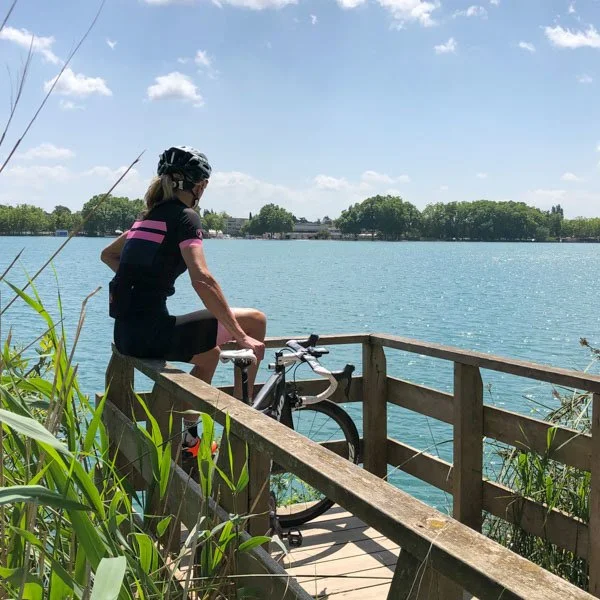
View over Lake Banyoles, near Girona, Costa Brava
| Great for: | Mix culture with fantastic riding in the place many pros call home |
|---|---|
| Where to stay: | Hotel Gran Ultonia, Girona |
| How to get there: | Barcelona el Prat airport (1.5 hours’ drive) |
Girona is undisputedly the cycling capital of Europe (yes, Port de Pollenca might have something to say on that, but in terms of towns/cities rather than regions, we think we’re on safe ground!).
The old town quarter with its cobbled streets, distinctive coloured buildings and spectacular cathedral is extremely charming and is well worth visiting with or without a bike.
It’s a place hundreds of professional cyclists call home and is a centre for professional teams to train in the spring and summer months whilst competing in central Europe. It sometimes seems that the town has geared a fair percentage of its local economy to the sport.
So if you’re looking for some of the best road cycling in Spain then look no further: Girona has a mix of flat and undulating terrain together with the odd challenging climb. About an hour’s riding from the town centre, the ascents of Rocacorba and Mare de Deu de Mont will test anyone’s legs. Nearer to base, the Els Angels climb is probably the most popular climb in the area.
Girona’s climate is perfect for cycling between March and November each year (although you should beware the fact the summers are hot!) whilst offering quiet, smooth roads. From Girona you can also head north west to the Girona Pyrenees and the Garrotxa National Park where there are more climbs to explore such as the testing ascent to the ski resort at Vallter 2000.
Find out more:
Our cycling guide to Girona has loads of information on riding here. There’s more info on the Garrotxa National Park in our Q&A with local cyclist Adrià Moreno. This article on gravel cycling in Girona might also be helpful. Or if you are looking to fine tune your fitness check out this article on training camps in Girona.
5. Costa Daurada

Picturesque inland villages and vineyards on the Costa Daurada
| Great for: | A temperate climate, super quiet roads with gentle gradients |
|---|---|
| Where to stay: | Estival el Dorado resort |
| How to get there: | Barcelona airport (1-hour drive) Tarragona Reus airport (20 mins drive) |
The Costa Daurada sits just south of Barcelona, on Spain’s north eastern coastline. Given the popularity of other well-established cycling centres, this area is working hard to build its reputation and at the moment still remains quite a pretty well-kept secret.
If you’re asking yourself where to cycle in Spain and simply want to get away from it all, the Costa Daurada and its long, sandy coastline is well worth a close look. It is extremely accessible location, being served by both Barcelona airports as well as nearby Tarragona. Two professional teams, Bahrain Merida and UAE Emirates, have held training camps recently in the area and there are now more and more cyclo tourists riding the roads around Cambrils and Salou.
The resort is an ideal place to clock up those pre-season base miles and whilst there are many flat roads adjacent to the coast there is no shortage of climbs in the Serra de Llaberia, Serra de Montsant and Muntanyes de Prades areas. Most of the ascents are under 10 kilometres in length at manageable gradients of between 3% and 6%.
The nearby city of Tarragona contains many ancient Roman ruins which date back to Julius Caesar’s reign, so if you’re cycling through Spain this year the Costa Daurada may be worth a look.
Find out more:
Our guide to cycling Costa Daurada has fantastic information on where to stay, ride and when to go. You might also be interested in the Terres de l’Ebre region, just to the south. Take a look!
6. San Sebastián, northern Spain
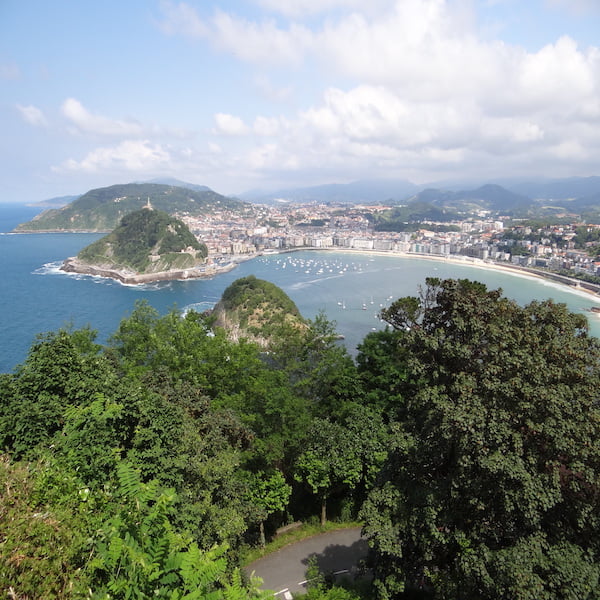
View down over San Sebastian, Spain
| Great for: | An eclectic mix of food, culture and steep climbs |
|---|---|
| Where to stay: | Parador de Hondarribia, Hondarribia |
| How to get there: | Bilbao airport (1.5-hour drive) |
The city of San Sebastián is the gastronomic capital of Spain, with more Michelin stars per capita than anywhere else in Europe. It’s clearly well worth a visit for the food alone! Add to this fact that it boasts one of the best beaches in the world, the stunning crescent shaped La Concha, and you can see why we like it!
Together with its own unique language, famed tapas and rolling verdant landscape, the region also has some killer climbs. Notable among these are the Monte Oiz and the Jaikibel, the latter being a staple of the Classica San Sebastián and the Tour of the Basque country races.
If you want to travel further west towards Bilbao, you find yourself in Vuelta country where some of the iconic climbs lie in wait – the Lagos de Covadonga, Alto del Angliru and La Farrapona to name but a few.
The weather can be blustery as it blows off the Bay of Biscay and it gets a fair amount of rain compared to the rest of Spain, but cycling is in the blood of the Basque people and if you are looking to go bike riding in Spain then you won’t be disappointed.
Find out more:
This article on cycling northern Spain is full of useful information.
Best cycling Canary and Balearic islands
Whether you want guided or self-guided cycling, Spain’s islands have plenty to offer.
Whilst Mallorca and Tenerife are far more established as cycling holiday destinations, Gran Canaria is catching up fast. With all year-round sunshine, testing climbs and quieter roads it’s not difficult to see why they are quickly growing in reputation.
For a long weekend break a two-and-a-half-hour flight to Mallorca certainly fits the bill, but for those who are not in a rush and don’t mind the extra two hours flying time the weather is likely to be warmer and the roads quieter in the Canary Islands.
In terms of when to go, Mallorca is a fantastic place to ride through spring and autumn. Summer can be very hectic with regular tourist traffic, and hot too. The Canary Islands, being that much further to fly and closer to the equator, have a more settled, warm climate all year long. We’ve focused on Gran Canaria below, but before deciding which island is for you, read our article that compares the eight different Canary Islands.
7. Mallorca
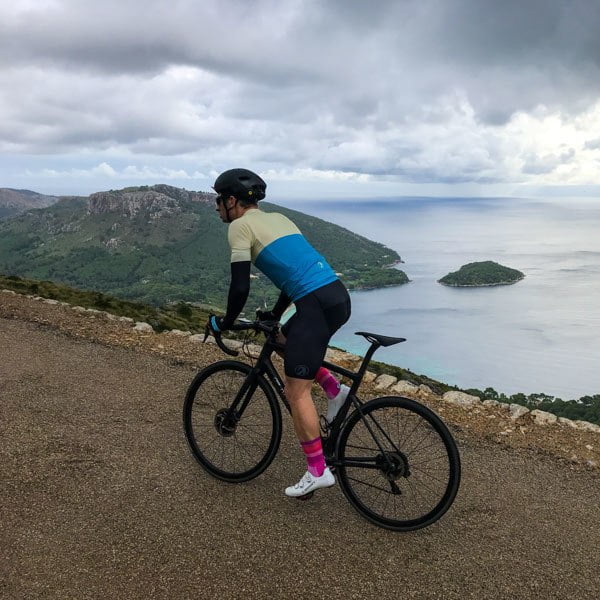
Cycling on Cap Formentor, Mallorca
| Great for: | Cycling with other cyclists, Temperate climate and good quality roads |
|---|---|
| Where to stay: | Hotel Illa d’Or, Port de Pollença |
| How to get there: | Fly into Palma Airport (1 hour to Port de Pollença) |
The largest of the Balearic Islands, Mallorca is recognised as one of the most popular cycling destinations in the world. with the town of Puerto Pollença being one of the major centres.
The island boasts 300 days of sunshine a year and combined with mild winters and easy accessibility from main European cities it is now seen as the number one ‘go to’ location for biking in Spain. Thousands of amateurs and a large number of professional teams go to the island each year either to train for the forthcoming season or simply to ride for pleasure.
For the amateur cyclist there is an ideal mix of terrain, from the Tramuntana mountain range in the west to the flat but very scenic roads in the east and south. Added to that of course you can test yourself on the same stretches of road that the professionals use whilst at their training camps.
The climbs of Sa Calobra, Formentor and Puig Major, whilst not as steep as the mountains you would find in mainland Europe, are extremely popular and packed with cyclists in the high season. The Mallorca 312 (a 312-kilometre sportive) is going from strength to strength, taking place every April and is now regarded as one of the best events in Europe.
As a popular tourist island, it also has a selection of hotels, bars, shops and restaurants to suit most tastes. The roads can get busy, with both cars and cyclists, so early morning starts in the peak months are recommended.
Find out more:
Our in-depth guide to cycling in Mallorca is a really great resource. It contains links to 20+ other guides and articles on riding on the island including the ever-popular Mallorca 312.
8. Tenerife
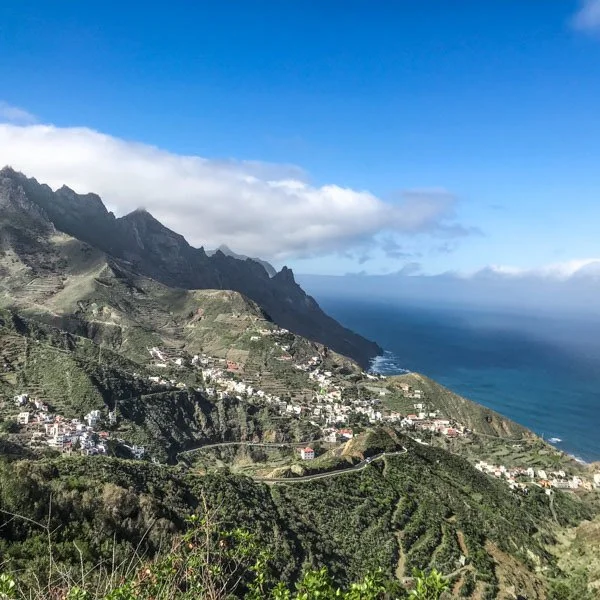
Tenerife’s northern coastline
| Great for: | Training at altitude with long climbs in fantastic weather |
|---|---|
| Where to stay: | Be Live, Playa Arena |
| How to get there: | Fly into Tenerife South airport (30 minutes’ drive) |
Tenerife has over the last ten years quickly become popular as a cycling destination, particularly during the winter months in the northern hemisphere.
Some of the professional teams soon realised that they could train both at altitude and in beautiful weather without flying long distance (flight time from the UK is 4.5 hours). As we know from the Mallorca experience, once the professional teams start to train somewhere new then the amateur cyclist soon follows and cycling facilities in the area start to improve. This certainly seems true in Tenerife’s case.
Some of the landscape on the island is dramatic, almost lunar in appearance, and formed out of volcanic rock. The centrepiece to the island is Mount Teide, which sits at 2,356 metres above sea level. To reach the summit you will ride of 45 kilometres at an average of just over 5%!
In addition to the five different routes up to Mount Teide, there are a host of other quality routes on the island none more so than a ride through the Anaga rural park. It’s a tough ride but you will be rewarded with stunning laurel forests, deep ravines, craggy peaks and tiny hamlets as you progress.
If you’re a mountain goat kind of a rider, we think you will particularly enjoy cycling in Tenerife.
Find out more:
Our detailed guide to cycling in Tenerife contains GPX files, routes and maps to help you plan your trip.
9. Gran Canaria
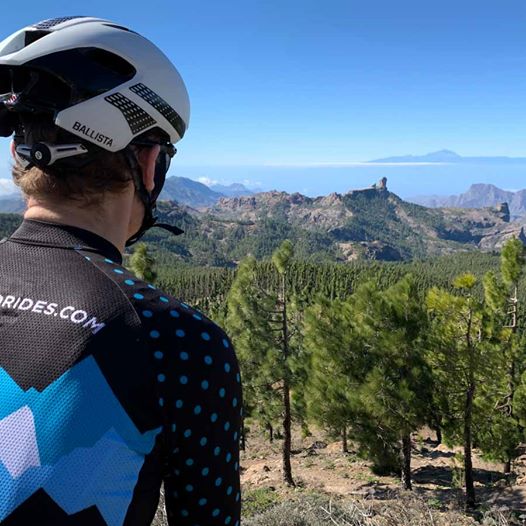
View to Tenerife from the top of Pico de las Nieves, Gran Canaria
| Great for: | Wall to wall sunshine, quiet roads, challenging climbs |
|---|---|
| Where to stay: | Gold by Marina, Maspalomas |
| How to get there: | Fly into Gran Canaria Airport (20 minutes’ drive to Maspalomas) |
The Canary island resort of Gran Canaria is quickly earning a reputation as a fantastic new cycling destination and is a great choice for winter cycling holidays. Sitting just 100 kilometres off the north western coast of Africa, it boasts some 3,000 hours of sunshine each year – that’s 8 hours per day on average. No wonder it’s the perennial favourite photo shot location for our kit partners, stolen goat!
But there’s much more to it than the weather, as the island has everything required to get you in shape for the forthcoming season. You’ll find challenging climbs, quality road surfaces as well as stunning coastal roads and deep canyons. The added advantage of it being a popular holiday destination also means that good hotels, shops and restaurants are in plentiful supply particularly in and around the southern coastal resorts such as Maspalomas.
The Vuelta a España has in recent years visited the island and raced to a stage finish at the summit of the popular Pico de las Nieves (Snow Peak). At 1,950 metres it is the highest point on the island.
One of the other highlights of Gran Canaria is the infamous Valley of Tears, probably the most revered climb on the island. It’s a brutal climb with sections at 25% and is clearly steep enough to test anyone’s legs!
Find out more:
We’re currently writing our guide to Gran Canaria. Sign up to our email list to be the first to hear about it!
Conclusion
There are plentiful opportunities for cyclists in Spain. Cycling holidays are available all over the mainland and islands, giving you a chance to get away into the sun. In most cases they’re also excellent value for money. You just need to make your choice. We hope this has helped!
What next?!
You can find links to all of our in-depth guides to cycling in Spain, here.
If you’re looking for someone to help organise your trip, check our review of some of the top cycling operators in Spain, and our article on how to pick a Spain cycling holiday.
Trying to work out if you can fly to one of the destinations we mention from where you live? We like this map of airports in Spain (and the world) which shows all the world’s airports and their scheduled flights an connections. It’s a useful starting point for your research.
We’d love to know your favourite places to ride. Leave a comment below to let us know!
Please support Epic Road Rides
A huge amount of time and effort goes into the article you’ve just read, all with the aim of helping you!
If you found what you’ve read useful, I’d really appreciate it if you dropped something in the tip jar here.
It’s a way you can say thank you and help us carry on creating top quality content with no annoying ads and no pay wall.
Looking for an organised cycling trip?
If you want someone to help you plan and book your cycling holiday, fill out this form. We aren’t a tour operator/agent but we work with lots of people who are and will do our best to put you in touch with someone that can help (within 24 hours wherever possible)!
The contents of this website are provided for general information purposes only. It is not intended to amount to advice and you should not rely on it. You should carry out your own due diligence and risk assessments and take professional advice. Views expressed by interviewees or other users of this website do not necessarily represent our views. We make no representations, warranties or guarantees, whether express or implied, that the content on our website is accurate, complete or up to date. If you use any information or content on this website, download from, or otherwise obtain content or services through our website, it is entirely at your own discretion and risk. Epic Road Rides Ltd disclaims all liability and responsibility arising from any reliance placed on the information and content on this website. Find out more here.

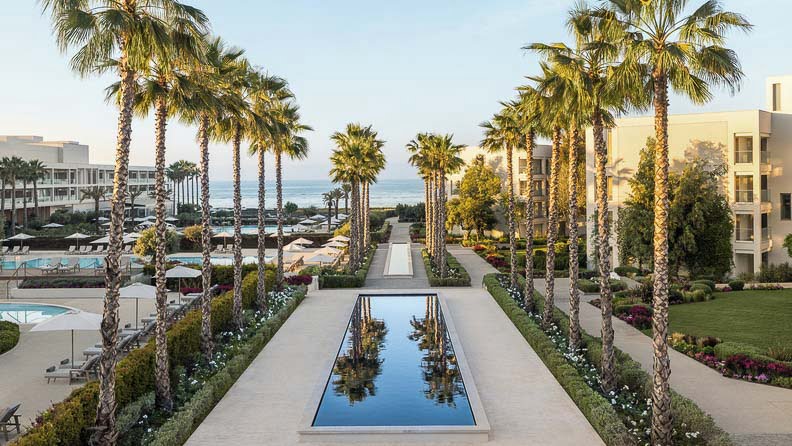






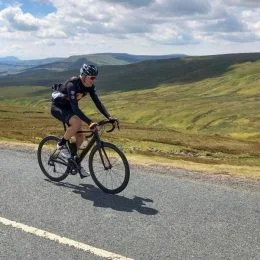
Hi Clare, you are actually forgetting the Asturias cycling paradise in northern Spain. From experience I can tell that this is truly heaven from a bike perspective.
Regards,
Kevin
Hi Kevin, sounds like an area we need to get to – I’ve heard from many people here that the riding is fantastic. Do you know the area well?